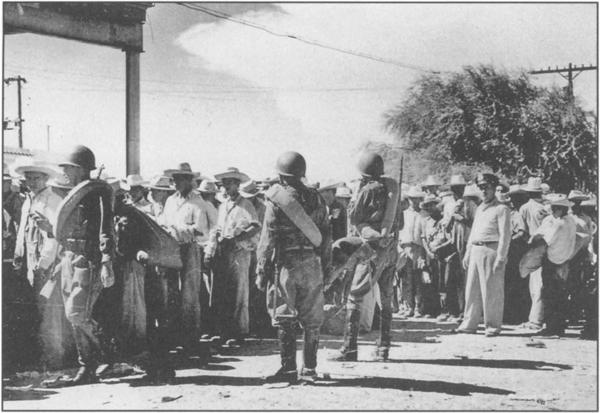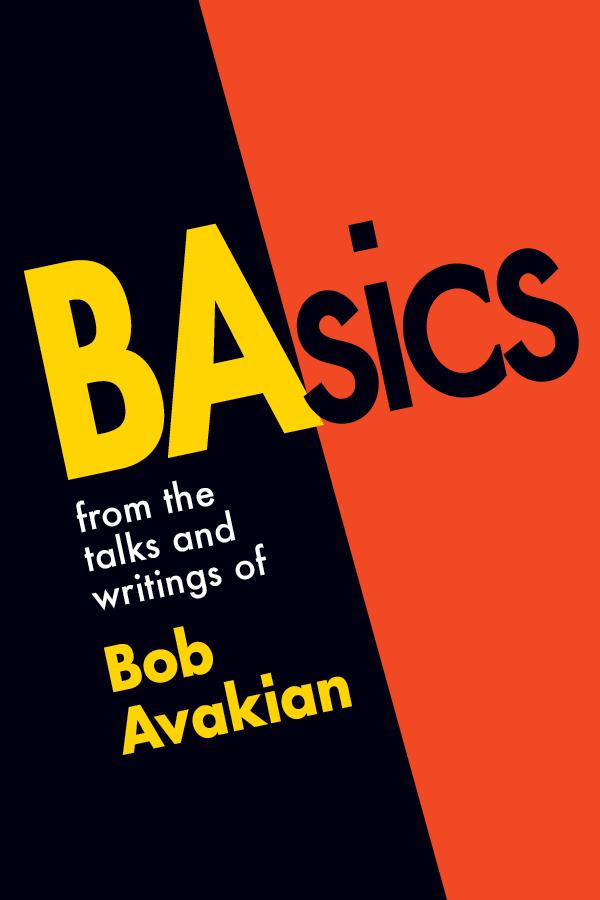Bob Avakian has written that one of three things that has “to happen in order for there to be real and lasting change for the better: People have to fully confront the actual history of this country and its role in the world up to today, and the terrible consequences of this.” (See “3 Things that have to happen in order for there to be real and lasting change for the better.”)
In that light, and in that spirit, “American Crime” is a regular feature of revcom.us. Each installment focuses on one of the 100 worst crimes committed by the U.S. rulers—out of countless bloody crimes they have carried out against people around the world, from the founding of the U.S. to the present day.
See all the articles in this series.


“Operation Wetback” was a U.S. government program of mass deportations of Mexican workers in the early 1950s. Above, Mexican officers guarding deportees awaiting train into Mexico at the Mexican side of the border.
Editors’ Note, November 11, 2024: One of the major parts of the horrific fascist agenda Trump intends to carry out once back in the White House is an extreme intensification of repression against immigrants, including driving millions of immigrants out of the U.S. Trump declared at the Republican National Convention this July that he would “launch the largest deportation operation in the history of our country," as the MAGA audience shouted “mass deportation now!” And he has repeated this threat many times. The Washington Post notes that Trump “points to an Eisenhower-era program [in the 1950s] known as ‘Operation Wetback,’ using a derogatory slur for Mexican migrants. The operation used military tactics to round up and remove migrant workers, sometimes transporting them in dangerous conditions that led to some deaths.” This was a horrendous injustice that rounded up and deported some 1.3 million immigrants, tearing apart families and terrorizing immigrant communities.
In this light, we are reposting the following article from our American Crime series.
THE CRIME: Beginning in June 1954 and continuing in one form or another through the summer of 1956, the U.S. government carried out a military-style campaign of round-ups and deportations of Mexicans living in the United States. They called it “Operation Wetback,” after the openly racist term for Mexicans and Mexican immigrants—”wetback”—first invoked to slander immigrants who crossed the Rio Grande River. “Operation Wetback” drove 1.3 million immigrants from the U.S., tearing apart immigrant families and terrorizing and decimating entire communities, especially in California, Arizona, and Texas. It intensified racial divisions and stoked the fires of hatred against Mexicans and immigrants for years to come.
With the launching of the operation, Border Patrol agents in California and Arizona, and later in Texas and other states across the country, reinforced by units from other areas, set up roadblocks, boarded trains, and cordoned off neighborhoods demanding to see people’s papers. At the outset of the campaign, 3,000 a day were rounded up. In the first three months alone, 170,000 were detained. Suspected “illegal aliens” were picked up on farms and other places of work, were turned over to immigration agents by employers, or were arrested by local police on vagrancy charges and held for the Border Patrol.
Bob Avakian, "Why do people come here from all over the world?"
Bob Avakian, "Why do people come here from all over the world?"
According to someone who lived through the experience, “In Los Angeles, in the center of the city, no one was shopping to buy anything, because of the raids. They [the INS] were grabbing people and deporting them. There were people with and without papers. There were family members who had their papers, but didn’t have them with them at that moment and they were taken away.” But there were no hearings or due process for those seized.
Immigrants were loaded onto trucks and dumped in border towns like Mexicali, Nogales, and Nuevo Laredo in the sweltering heat of summer with little provision for their survival. According to one historian, some 88 “died of sun stroke as a result of a round-up that had taken place in 112-degree heat, and [an American labor official] argued that more would have died had the Red Cross not intervened. At the other end of the border, in Nuevo Laredo, a Mexican labor leader reported that ‘wetbacks’ were ‘brought like cows’ on trucks and unloaded fifteen miles down the highway from the border, in the desert.”


Across the Borderline, featuring Bob Avakian
Listen on Soundcloud
Calculated efforts were made to instill fear and encourage “self deportation.” Some deportees had their heads shaved, marking them in case they tried to cross back over the border. Others were put on trains and buses, ships and planes and sent deep into the interior of Mexico without regard to their places of origin. Thousands of immigrants were brought to Port Isabel, Texas, and packed into filthy cargo ships bound for Veracruz, Mexico. An investigation compared one of these vessels to “an 18th century slave ship.” On one trip, 500 were packed on the Mercurio, a ship meant to hold 90. Conditions were so bad 40 immigrants jumped overboard, with seven drowning, sparking a rebellion aboard the ship.
The INS claimed it drove 1.3 million immigrants from the U.S. through the summer of 1954. It boasted that hundreds of thousands left the country because of the fear that racist propaganda and heartless actions had generated. Whether or not the INS figures are exact, it's clear “Operation Wetback” brought widespread suffering, anguish, and by some estimates, hundreds of deaths.
IN THEIR OWN WORDS:
“Just give them [the Border Patrol] some live ammo, let them shoot a few people. Then everyone will be scared and they won’t come across the border.”
– U.S. Attorney General Herbert Brownell (1953-1957)
“We used to buy our slaves, now we rent them from the government.”
– Texas grower, on being assured by the INS that “Operation Wetback” would not prevent growers from having a ‘free hand’ with Mexican immigrant laborers turned over to them.
THE CRIMINALS:
President Dwight Eisenhower (1952-1960) and Attorney General Herbert Brownell. They conceived, advocated, and organized “Operation Wetback.”
Lt. General Joseph Swing, a veteran of the U.S.’s 1916 invasion of Mexico (an unsuccessful campaign to hunt down the revolutionary nationalist leader Pancho Villa) and head of the Immigration and Naturalization Service (INS). Swing organized “Operation Wetback” as a military-type campaign. He claimed that an “alarming, ever increasing flood tide” of undocumented migrants from Mexico constituted “an actual invasion of the United States.” He boasted that “Operation Wetback” was a “direct attack . . . upon the hordes of aliens facing us across the border.”
THE ALIBI: The advocates for “Operation Wetback” claimed that “illegal” immigration was undermining wages and robbing U.S. citizens of jobs, while driving up costs in health care and other social services. They claimed that the border was out of control, immigrants were pouring across, and the INS was helpless to stop them. The INS claimed that immigrants had “criminal tendencies.” In the words of one official, “because the ‘wetback’ starts out by violating a law . . . it is easier and sometimes appears even more necessary for him to break other laws since he considers himself to be an outcast, even an outlaw.”
Popular pictorial magazines, weekly news publications, and newspapers had paid little heed to the generally miserable conditions of Mexican workers in the fields of California, Arizona, Texas, and elsewhere. Yet in the months prior to “Operation Wetback,” they began to show intense interest in the “dramatic influx” of “illegals” and their impact on American life. “This week,” wrote Time magazine in its April 27, 1953 edition, “wetbacks were seeping across the border at a record breaking rate—two a minute, day and night. ‘Like ants,’ said Chief Patrol Inspector Ed Parker. ‘They’re swarming over the deserts like ants.’ U.S. Attorney General Brownell warned, ‘wetback smuggling’ has mushroomed into a grave social problem involving murder, prostitution, robbery, and a gigantic narcotics infiltration…a malignant threat to the growth of our society.’”
“Operation Wetback” took place during the Cold War clash between the U.S. and the Soviet Union, and anti-immigrant hysteria was also being fanned by “red scare” rhetoric. The acting immigration commissioner told a House subcommittee in 1953, “A harvest of dangerous byproducts from the seemingly harmless invasion by illegal aliens is now in the making. Who can say that communists and subversives do not cross the Rio Grande?”
THE ACTUAL MOTIVE: The purpose of “Operation Wetback” was to maintain tight control over Mexican immigrant labor, whose super-exploitation was the backbone and foundation of the economy in the Southwest. It also aimed to prevent this workforce from rising above the level of near-slavery by settling down and becoming part of the civil, social, and political life of the region and helped to maintain white supremacy overall.
Soon after Texas, Arizona, and California (along with other states) were seized from Mexico in the war of 1846-1848, a labor system was set in motion which relied on immigrant labor. By the 1920s, Mexico became the preferred supplier of labor in the expanding agricultural industry in the U.S. Southwest. Due in large part to American domination and exploitation of their homeland, conditions for peasant farmers and workers in Mexico were so horrendous that hundreds of thousands were willing to endure great abuses so their families could survive. The INS and Border Patrol were not developed mainly to “defend” the border, but to regulate the labor supply—opening the border “gates” when labor was needed, driving workers out when not.
A more structured labor system came into being in 1941 when the U.S. negotiated an agreement with Mexico for a program of contracted labor called the Bracero Program. “Bracero” means arm, and that’s how U.S. capitalists treated immigrant workers—not as human beings but as bodies to be ruthlessly exploited. “Braceros” were contracted to work in the fields and rail yards, often paid only 50-60 percent of the prevailing wage, and obligated to leave the U.S. when their contracts ran out. Conditions for “braceros” were so terrible that many escaped from their contracting employers and sought work elsewhere in the fields, or in cities like Los Angeles, San Francisco, and Chicago. Even without papers, they became more settled and part of U.S. society and more connected to existing Mexican-American communities than the short-term and closely controlled “braceros.”
The growth of Mexican communities in the post-World War 2 era, along with a period of economic downturn in 1953, created a clamor for controlling the flow of undocumented immigrants. “Operation Wetback” was aimed at driving out workers who were not contracted as braceros, while stopping, and reversing, the growth of these non-white communities.
Even as immigrants were being rounded up, U.S. authorities made sure the supply of cheap, vulnerable labor was maintained. One goal of “Operation Wetback” was to round up thousands of undocumented workers and “convert” them into “braceros,” a process labeled “drying out the wetbacks.” Meanwhile, the number of “braceros” brought into the U.S. actually doubled (from 148,000 to 298,000) in the over two years that “Operation Wetback” was in effect.
Sources:
Juan Ramon Garcia, “Operation Wetback”: The Mass Deportation of Mexican Undocumented Workers in 1954 (Greenwood Press, 1980)
Kitty Calavita, Inside the State: The Bracero Program, Immigration, and the I.N.S. (Quid Pro Books, 2010)
Richard D. Vogel, Stolen Birthright: The U.S. Conquest and Exploitation of the Mexican People, (Houston Institute of Culture (http://www.houstonculture.org/hispanic/conquest.html)
Interview with a veteran of the Bracero period, May 1995
Mae M. Ngai, Impossible Subjects: Illegal Aliens and the Making of Modern America (Princeton University Press, 2004)
Handbook of Texas Online, Fred L. Koestler, “Operation Wetback,” accessed September 28, 2016, http://www.tshaonline.org/handbook/online/articles/pqo01.

